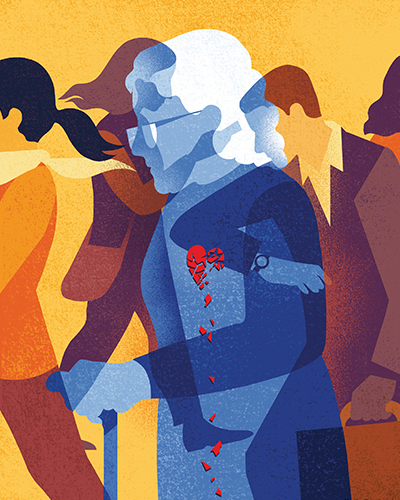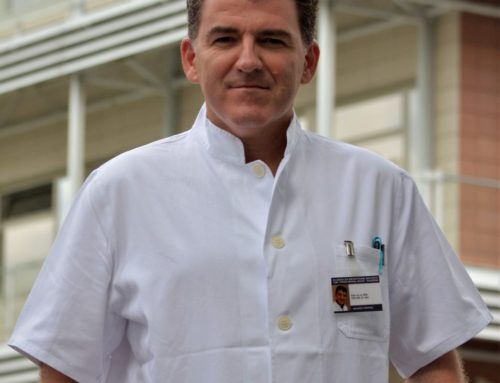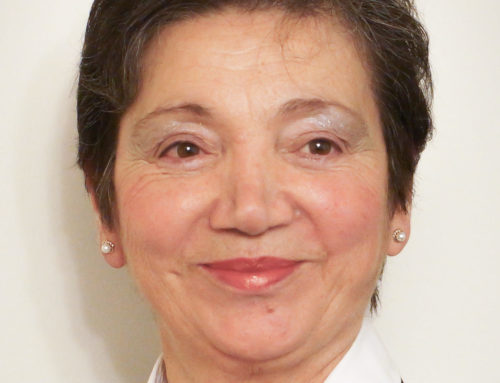FR. GERALD A. ARBUCKLE, SM, PhD

Illustration by Kasia Bogdanska
Loneliness is the feeling of being disconnected, excluded and disengaged from others, an agonizing feeling of emptiness or desolation, a feeling that no one cares. At the same time there is the yearning to belong, a restlessness to make a satisfying relationship, to feel valued. Prior to the coronavirus pandemic, loneliness had been identified as the next global health epidemic of the 21st century.1 But, in early 2020, the COVID-19 pandemic generated forces that have intensified widespread loneliness beyond what was even imagined in the 2019 projection.
The tragic consequences of this loneliness will endure for decades, if not generations, as they did following the worldwide Great Depression of the later 1920s and 1930s. The economic crisis caused by the pandemic has hurled even developed countries back to visions of the sufferings of those times.
The pandemic has two branches: a contagious disease and an economic malaise. Hundreds of thousands have died from the disease. Medical services, already under pressure, are struggling to cope, often unsuccessfully; the pandemic calls for stark choices between life, death and the economy.2 The scale of the health crisis is generating unparalleled challenges for the global economy. That, in turn, results in a massive increase in poverty, which is the major cultural cause of loneliness. Poverty excludes people from a sense of belonging, with often tragic physical and mental consequences.3
Since the pandemic has reinforced the existing poverty of people and suddenly cast millions more into its appalling grips, this article seeks to describe the meaning of poverty. Globally, the least advantaged are suffering the most as a consequence of the pandemic.
How a problem is articulated and then elucidated strongly affects what is actually done about it. Inaccurate assessments of poverty, along with unsympathetic attitudes, unvaryingly result in bad policies and practices that intensify the alienation and loneliness of people. Frequently poverty is measured only in quantifiable terms such as low income, inadequate housing, sickness and levels of educational achievement. This gives an inadequate picture of the reality. Qualitative analysis is also essential. Additional qualitative definitions of poverty need to be considered as well as how they are all interconnected and reinforce each other.
Poverty as Quantifiable
The International Monetary Fund’s global economic outlook catalogs a high-speed economic train crash that will see unemployment, debt and bankruptcies soar more precipitously than ever before.4 Even in the most optimistic scenario, the global economy will shrink 30 times more than it did during the global financial crisis of 2008. The consequences are that absolute and relative poverty rates are rising dramatically, leading to an intensification of loneliness.
Absolute poverty is defined by a set income measure below which people experience complete destitution such that they cannot meet even minimum needs for food and shelter. The United Nations Development Programme has set this measure as one U.S. dollar a day for people living in third- and fourth-world countries. Below that income threshold people experience severe malnutrition and perilous levels of ill health. Relative poverty, on the other hand, is more helpful in assessing how material and income levels impact people’s lives. The term “relative poverty” refers to “the lack of resources needed to obtain the kinds of diet, participate in the activities and have the living conditions and amenities that are widely approved and generally obtained by most people in a particular society.”5 When resources are so below others in society, sufferers are effectively excluded from ordinary, socially essential, living arrangements and activities.
In the United States five years before the pandemic, it was estimated that 18.4 million people lived in absolute poverty according to the standard set by that country. 6 In 2016, it was estimated that there were over a half million people in the United States classed as homeless, 8% of whom are veterans. 7 Homeless people have no place to self-isolate in an epidemic but the streets. In 2015, there were 43.1 million people in relative poverty. 8 Four of ten adults would not have the resources available to cover an unplanned $400 expense. 9 An “expensive and inefficient medical system” reinforces the degree of poverty of Americans: those “in the bottom fourth of the income distribution die about 13 years younger on average than those in the top fourth.”10
Since the start of the pandemic, however, the two types of poverty have dramatically increased. The abrupt rise in unemployment is projected to rise at a rate “not seen since the Great Depression.” 11 By mid-April 2020, within a three week period, 22 million people in the United States had registered for unemployment benefits.12 Even middle-class Americans, once so comfortably secure, fear what the future may bring.
The impact of the disease has not fallen evenly; the cavernous divides in American society are widening. Those living on low incomes have incidences of illness and poor health at much higher rates than people on high incomes. Even before the pandemic hit, the U.S. was in the throes of a massive health crisis: “In 2015 life expectancy began falling for the first time since…1993. The causes – mainly suicides, alcohol-related deaths, and drug overdoses – claim roughly 190,000 lives each year.”13
Many people who were “already on the margins before the pandemic have now been pushed over the edge. It is appalling…that blacks and Hispanics are becoming sick and dying at disproportionate rates. Decades of racism left many minority Americans with crowded housing, bad health and little savings, making it more difficult to survive the pandemic.”14 In April 2020 in New York City, data showed that black and Hispanic residents were twice as likely to die of coronavirus as white city dwellers; they were less likely to have health insurance, and thus may have avoided seeking testing and treatment. 15
Poverty as Opportunity Deprivation
People can become so imprisoned by their low income that it is extremely difficult for many to break through its crushing circumstances. We speak of a cycle of poverty, simply because the factors referred to are interconnected and self-perpetuating.
Since this crippling cycle of poverty prevents or obstructs people from participating as full members of society, poverty can be defined as “deprivation of opportunities” or simply “capability deprivation.”All have the right to work, to participate in society and to grow intellectually, emotionally and spiritually. All people have responsibility for each other’s well-being; everyone should have opportunities to meet their responsibilities and to contribute to society.16 But structures of society can render these rights and responsibilities impossible for groups in society to achieve. People trapped in the circle of poverty have a restricted range of choices available to them. To be poor is “to be denied the chance to enjoy the consumption of goods, or the ability to achieve and maintain good health, or participate in social activities or other aspects of community life.”17
Lack of equality of educational opportunity is a significant contributor to the rigidity of poverty. In the United States, “Virtually the entire increase in mortality has been among white adults without bachelor’s degrees – some 70 percent of all whites.”18 Educational needs in socio-economically depressed areas require significant input of finance and specialized staff, but, in fact, they get less than the demand needed in terms of buildings, facilities, equipment and teachers, particularly those relating to special needs. Moreover, people with no housing, or inadequate housing, find it extremely difficult, or sometimes impossible, to obtain ordinary services such as a bank account, a credit card, or develop a regular relationship with local schools and doctors.
Poverty as Stigmatizing and Discriminating
Unless we look at poverty from the structural, cultural, entrapping perspective, we will tend to blame the victim for their poverty, social exclusion and loneliness. Statements like “the poor can themselves get out of poverty, if they truly want to” are dangerously simplistic and do nothing to clarify our understanding of the complexity of poverty and its ability to crush initiative and self-respect. In the United States, people who are poor, especially if they are single mothers, African-Americans or Hispanics, are frequently blamed for being poor by members of the dominant culture.
Cultures have a built-in tendency to create boundaries with powerful feelings dividing “us” from “them.” The English poet Rudyard Kipling described the dynamic in this way: “All nice people like Us are We, and everyone else is They.” The “They” are stigmatized, especially through extensive mass media publicity, as inferior, thus to be blamed and marginalized for their assumed deficiencies.19 When cultures are under pressure of change, such as the impact of the pandemic, the stigmatizing process intensifies. Vulnerable people, such as migrants, minority groups, people who are poor, are today in constant danger of being wrongfully blamed, stigmatized and further marginalized for causing the virus or the resultant unemployment.
The impact on victims of being blamed, stigmatized and marginalized is often horrific and long lasting. They feel shamed, worthless and blamed for their own poverty. A sense of chronic loneliness or fatalism can grip them, as their sense of self-worth and self-respect disintegrate. We need to become keenly aware of what happens to human dignity once hope becomes a forgotten word.
The psalmist describes the inner anguish of people who have been stigmatized and socially marginalized: “You have deprived me of my friends, made me repulsive to them, imprisoned, with no escape” (Ps 88:8). You can sense the pain also in the cry to Jesus by Bartimaeus: “let me see again” (Mark 10:51). Human dignity cannot be subjected to endless indignities and remain intact…








